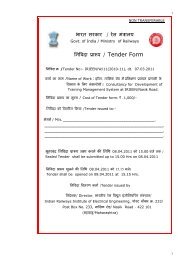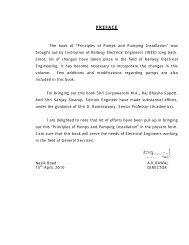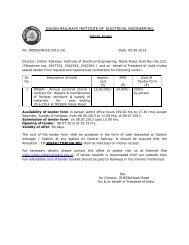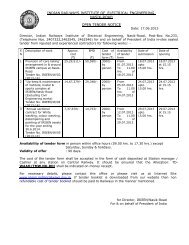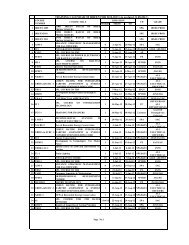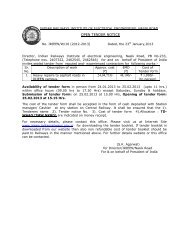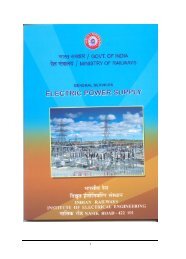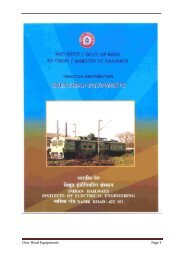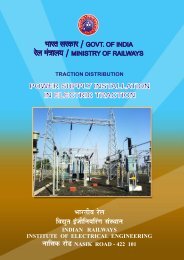Traction Rolling Stock - Indian Railways Institute of Electrical ...
Traction Rolling Stock - Indian Railways Institute of Electrical ...
Traction Rolling Stock - Indian Railways Institute of Electrical ...
You also want an ePaper? Increase the reach of your titles
YUMPU automatically turns print PDFs into web optimized ePapers that Google loves.
y the driver’s vacuum brake valve.<br />
c) Air admission valve (B8), attached to the train pipe and<br />
d) Timing chamber (B22) to control sensitivity <strong>of</strong> air admission valve, controlled<br />
by the driver’s vacuum brake valve.<br />
e) Timing chamber to control sensitivity <strong>of</strong> air admission valve controlled by<br />
conditions in the equalising reservoir (B20).<br />
The exhausters (B1) with standard auxiliaries such as filter/strainer, non-return valve,<br />
vacuum relief valve, etc. are directly connected to the train pipe through 2 inch exhauster cut out<br />
valves, solenoid operated for vacuum creation and destruction. These cut out valves are energised<br />
to isolate the exhausters when the handle on the Driver’s vacuum brake valve is moved towards<br />
'brake on' but one exhauster always remains in communication with train pipe through a small bypass<br />
in exhauster cut out valve (VA-1 release valve) B6 and with the small equalising reservoir.<br />
With the further movement <strong>of</strong> DVB <strong>of</strong> graduated application zone, i.e. towards 'brake on' the<br />
atmospheric air is admitted to E.Q. reservoir at a faster rate with more port opening in DVB, but<br />
the size <strong>of</strong> the connection <strong>of</strong> E Q. reservoir to exhauster remains unaltered. With result a balance<br />
is set up between air admitted and air extracted for each position <strong>of</strong> DVB. The progressive<br />
reduction <strong>of</strong> vacuum in E.Q. reservoir to the required value operates the air admission valve<br />
diaphragm to admit atmospheric air directly into the train pipe. This action is quite automatic and<br />
over braking due to leakages in vacuum system/train pipe is compensated by continuous<br />
extraction <strong>of</strong> air from train pipe through by-pass hole in VA-1 release valve. A small timing<br />
chamber regulates the rate <strong>of</strong> fall <strong>of</strong> train pipe vacuum independent <strong>of</strong> rate <strong>of</strong> DVB handle<br />
movement.<br />
a) During emergency application <strong>of</strong> DVB, atmospheric air is also supplied by<br />
DVB directly through 2" diameter pipe in addition to the air admission valve to<br />
destroy vacuum at the quickest possible rate.<br />
b) For a partial release DVB handle is returned to full release position until the<br />
desired restoration <strong>of</strong> vacuum has taken place in T.P. and then it is only<br />
necessary to keep DVB in suitable notch to maintain desired vacuum level.<br />
c) The operation <strong>of</strong> emergency (flap type) valve directly connects the train pipe to<br />
atmosphere through 2" diameter opening thereby applying brakes on loco and<br />
trailing stock at the quickest possible rate and shuts <strong>of</strong>f exhausters in addition to<br />
regression.<br />
d) The main reservoir also supplies compressed air to control equipment such as<br />
horns, wipers, pantograph, auxiliary circuit but at the time <strong>of</strong> initial energisation<br />
when there is insufficient pressure in control /emergency reservoir to raise the<br />
pantograph, the auxiliary compressor (battery operated) is started to raise the<br />
pressure in auxiliary circuit to energise the locomotive,<br />
7.1.5 Setting <strong>of</strong> different valves <strong>of</strong> Vacuum brake system<br />
Driver's independent self-lapping : 3.5 ± 0.1 kg/cm²




